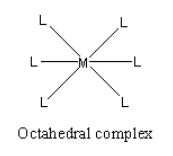
An octahedral complex is formed when hybrid orbitals of the following types are involved:
A. ${\text{s}}{{\text{p}}^{\text{3}}}$
B. ${\text{ds}}{{\text{p}}^{\text{2}}}$
C. ${{\text{d}}^2}{\text{s}}{{\text{p}}^3}$
D. None of these
Answer
462k+ views
Hint: The octahedral complexes form when six ligands approach to the metal so, metal in an octahedral complex requires six hybrid orbitals for the interaction with ligands. Hybrid orbitals are formed by the mixing of s, p and d orbitals.
Complete Step by step answer: When six ligands approach to the metal from in between the axis octahedral complex forms.
The metal requires the orbitals of the same energy to interact with all ligand approaching it. The concept that tells the formation of orbitals of the same energy is hybridization. Hybridization tells the mixing of metal orbitals to form the orbitals of the same energy.
The orbitals s, p, d and f, all have a different energy. So, hybridization tells that some orbitals (as required) of the metal mix and form new orbitals in the same number. All newly formed orbitals have the same energy and are known as hybrid orbitals.
In an octahedral complex, metal requires six orbitals of the same energy.
Two d-orbital, one s and two p-orbital combine and form six hybrid orbital. The hybridization is known as ${{\text{d}}^{\text{2}}}{\text{s}}{{\text{p}}^{\text{3}}}$ hybridization.
When one s-orbital, two p-orbital and one d-orbital combine and form six hybrid orbital. The hybridization is known as ${\text{s}}{{\text{p}}^{\text{3}}}{{\text{d}}^{\text{2}}}$ hybridization.
A general octahedral complex is shown as follows:

In ${{\text{d}}^{\text{2}}}{\text{s}}{{\text{p}}^{\text{3}}}$ hybridization, the inner d-orbital is involved and in ${\text{s}}{{\text{p}}^{\text{3}}}{{\text{d}}^{\text{2}}}$ hybridization outer d-orbital is involved.
Therefore, option (C) ${{\text{d}}^{\text{2}}}{\text{s}}{{\text{p}}^{\text{3}}}$, is correct.
Note: Hybrid orbitals form sigma bond only. The name of the complex itself indicates the number of hybrid orbitals such as the octahedral complex has six hybrid orbitals so, the hybridization can be ${{\text{d}}^{\text{2}}}{\text{s}}{{\text{p}}^{\text{3}}}$ or . The hybridization ${\text{s}}{{\text{p}}^{\text{3}}}$and ${\text{ds}}{{\text{p}}^{\text{2}}}$shows the presence of four hybrid orbitals. Square planar complex has hybridization ${\text{ds}}{{\text{p}}^{\text{2}}}$and the tetrahedral complex has hybridization ${\text{s}}{{\text{p}}^{\text{3}}}$.
Complete Step by step answer: When six ligands approach to the metal from in between the axis octahedral complex forms.
The metal requires the orbitals of the same energy to interact with all ligand approaching it. The concept that tells the formation of orbitals of the same energy is hybridization. Hybridization tells the mixing of metal orbitals to form the orbitals of the same energy.
The orbitals s, p, d and f, all have a different energy. So, hybridization tells that some orbitals (as required) of the metal mix and form new orbitals in the same number. All newly formed orbitals have the same energy and are known as hybrid orbitals.
In an octahedral complex, metal requires six orbitals of the same energy.
Two d-orbital, one s and two p-orbital combine and form six hybrid orbital. The hybridization is known as ${{\text{d}}^{\text{2}}}{\text{s}}{{\text{p}}^{\text{3}}}$ hybridization.
When one s-orbital, two p-orbital and one d-orbital combine and form six hybrid orbital. The hybridization is known as ${\text{s}}{{\text{p}}^{\text{3}}}{{\text{d}}^{\text{2}}}$ hybridization.
A general octahedral complex is shown as follows:

In ${{\text{d}}^{\text{2}}}{\text{s}}{{\text{p}}^{\text{3}}}$ hybridization, the inner d-orbital is involved and in ${\text{s}}{{\text{p}}^{\text{3}}}{{\text{d}}^{\text{2}}}$ hybridization outer d-orbital is involved.
Therefore, option (C) ${{\text{d}}^{\text{2}}}{\text{s}}{{\text{p}}^{\text{3}}}$, is correct.
Note: Hybrid orbitals form sigma bond only. The name of the complex itself indicates the number of hybrid orbitals such as the octahedral complex has six hybrid orbitals so, the hybridization can be ${{\text{d}}^{\text{2}}}{\text{s}}{{\text{p}}^{\text{3}}}$ or . The hybridization ${\text{s}}{{\text{p}}^{\text{3}}}$and ${\text{ds}}{{\text{p}}^{\text{2}}}$shows the presence of four hybrid orbitals. Square planar complex has hybridization ${\text{ds}}{{\text{p}}^{\text{2}}}$and the tetrahedral complex has hybridization ${\text{s}}{{\text{p}}^{\text{3}}}$.
Recently Updated Pages
Can anyone list 10 advantages and disadvantages of friction

What are the Components of Financial System?

How do you arrange NH4 + BF3 H2O C2H2 in increasing class 11 chemistry CBSE

Is H mCT and q mCT the same thing If so which is more class 11 chemistry CBSE

What are the possible quantum number for the last outermost class 11 chemistry CBSE

Is C2 paramagnetic or diamagnetic class 11 chemistry CBSE

Trending doubts
Which is not a source of freshwater 1 Glaciers and class 11 chemistry CBSE

10 examples of friction in our daily life

The correct order of melting point of 14th group elements class 11 chemistry CBSE

Difference Between Prokaryotic Cells and Eukaryotic Cells

One Metric ton is equal to kg A 10000 B 1000 C 100 class 11 physics CBSE

What is the specific heat capacity of ice water and class 11 physics CBSE




